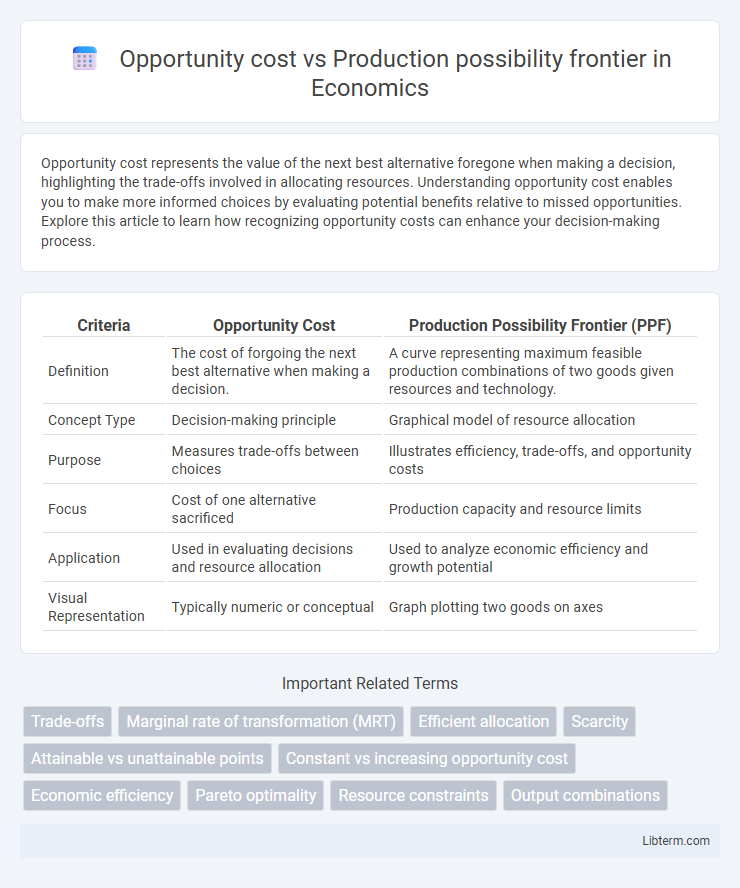Opportunity cost represents the value of the next best alternative foregone when making a decision, highlighting the trade-offs involved in allocating resources. Understanding opportunity cost enables you to make more informed choices by evaluating potential benefits relative to missed opportunities. Explore this article to learn how recognizing opportunity costs can enhance your decision-making process.
Table of Comparison
| Criteria | Opportunity Cost | Production Possibility Frontier (PPF) |
|---|---|---|
| Definition | The cost of forgoing the next best alternative when making a decision. | A curve representing maximum feasible production combinations of two goods given resources and technology. |
| Concept Type | Decision-making principle | Graphical model of resource allocation |
| Purpose | Measures trade-offs between choices | Illustrates efficiency, trade-offs, and opportunity costs |
| Focus | Cost of one alternative sacrificed | Production capacity and resource limits |
| Application | Used in evaluating decisions and resource allocation | Used to analyze economic efficiency and growth potential |
| Visual Representation | Typically numeric or conceptual | Graph plotting two goods on axes |
Understanding Opportunity Cost: A Fundamental Concept
Opportunity cost represents the value of the next best alternative forgone when making a decision, serving as a critical measure in resource allocation. The production possibility frontier (PPF) illustrates the trade-offs between two goods, showing the maximum feasible output combinations given limited resources. Understanding opportunity cost is essential for interpreting points along the PPF, as moving production from one good to another involves sacrificing potential output, thus highlighting the cost of choice in economic decision-making.
What is the Production Possibility Frontier (PPF)?
The Production Possibility Frontier (PPF) is a graphical representation showing the maximum output combinations of two goods or services an economy can achieve using all available resources efficiently. It illustrates the concept of opportunity cost by highlighting the trade-offs involved in reallocating resources from the production of one good to another. Points on the PPF indicate efficient production levels, while points inside represent inefficiency, and points outside are unattainable with current resources.
Opportunity Cost Illustrated on the PPF Curve
Opportunity cost on the Production Possibility Frontier (PPF) curve is illustrated by the trade-off between two goods, showing how producing more of one good requires sacrificing some amount of the other. The slope of the PPF represents the opportunity cost, highlighting the maximum possible output combinations when resources are fully and efficiently utilized. As production moves along the curve, increasing opportunity costs often appear due to resource specialization and inefficiencies.
Key Assumptions Behind the PPF Model
The Production Possibility Frontier (PPF) model assumes fixed resources and technology, full employment, and efficient use of resources, illustrating trade-offs in production choices. Opportunity cost is represented by the slope of the PPF, indicating the amount of one good sacrificed to produce more of another. These key assumptions enable the PPF to demonstrate scarcity, choice, and opportunity cost clearly within an economy.
Shifts in the PPF and Changing Opportunity Costs
Shifts in the Production Possibility Frontier (PPF) occur due to changes in resource availability, technological advancements, or labor productivity, which expand or contract the economy's production capacity. Changing opportunity costs are reflected in the PPF's shape; a bowed-out curve indicates increasing opportunity costs as more resources are reallocated between goods. An outward shift in the PPF lowers opportunity costs by allowing greater production of both goods, while an inward shift increases opportunity costs due to reduced productive resources.
Comparative Advantage as a Result of Opportunity Cost
Opportunity cost is the value of the next best alternative foregone when making a decision, and it directly influences the shape and position of the Production Possibility Frontier (PPF), which illustrates the maximum output combinations of two goods. Comparative advantage arises from differences in opportunity costs between producers, enabling specialization where each party produces goods at a lower opportunity cost than others. This specialization, guided by comparative advantage, allows for more efficient resource allocation and potential gains from trade reflected along the PPF.
Real-World Applications of the PPF and Opportunity Cost
The Production Possibility Frontier (PPF) illustrates the trade-offs and opportunity costs faced by economies when allocating scarce resources between alternative goods. In real-world applications, the PPF helps policymakers evaluate the cost of shifting resources, such as labor and capital, from one sector to another to maximize economic efficiency. Businesses use opportunity cost analysis alongside the PPF to decide on investment strategies, balancing production priorities to achieve optimal resource utilization and growth.
Efficient Resource Allocation: Maximizing Output
Opportunity cost represents the trade-offs in resource utilization, highlighting the cost of foregone alternatives when producing one good over another. The Production Possibility Frontier (PPF) graphically illustrates the maximum output combinations of two goods achievable with efficient resource allocation, ensuring no resources are wasted. Operating on the PPF curve maximizes output by allocating resources in a way that balances opportunity costs, reflecting optimal efficiency in production.
Limitations and Criticisms of the PPF Model
The Production Possibility Frontier (PPF) model simplifies economic reality by assuming only two goods can be produced and constant technology, which limits its applicability in complex economies with multiple goods and dynamic technological changes. It also ignores factors such as unemployment, resource heterogeneity, and economies of scale, making the opportunity cost depicted by PPF less precise in real-world scenarios. Critics argue that the PPF's assumptions of full employment and efficient resource allocation do not hold in practice, reducing its effectiveness in capturing actual opportunity costs faced by producers and policymakers.
Opportunity Cost and PPF in Economic Decision-Making
Opportunity cost measures the trade-off between choices by quantifying the value of the next best alternative when resources are limited. The Production Possibility Frontier (PPF) graphically represents the maximum output combinations of two goods, illustrating opportunity costs as the curve's slope shows how much of one good must be sacrificed to produce more of the other. Economic decision-making uses the PPF to evaluate opportunity costs, guiding efficient resource allocation and maximizing productive potential.
Opportunity cost Infographic

 libterm.com
libterm.com